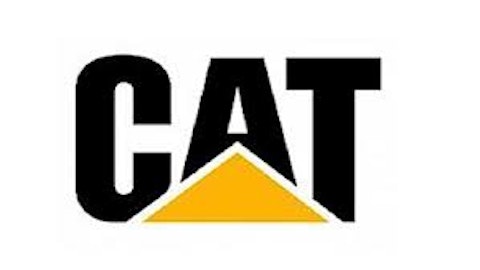Just a couple years ago, Caterpillar Inc. (NYSE:CAT) was one of my favorite stocks. The Chinese economy was booming and there was so much demand for all kinds of materials (including but not limited to the precious metals like gold and silver), which fueled strong results for the company. Then things came to a halt as some materials lost value and the Chinese economy came to a slowdown. On Wednesday evening, Caterpillar Inc. (NYSE:CAT) announced its quarterly earnings and things don’t look that bright for the company at the moment.
Latest results

Half of the revenue decline stemmed from decreased inventory while the other half was a result of weak demand. This resulted in a sell-off in Caterpillar Inc. (NYSE:CAT)’s shares, bringing the share price down to $83. In the last 52 weeks, the company traded in a range of $79 and $99, which means that the stock’s current price is much closer to its 52-week low than its 52-week high.
Maybe it’s a little unfair to compare the second quarter of 2013 with the second quarter of 2012 (even though it makes perfect sense) because the second quarter of 2013 was the best quarter of Caterpillar Inc. (NYSE:CAT)’s history in terms of revenue and profits; therefore, it might have been an outlier. Keep in mind that in the second quarter of 2012, dealers ordered more products than they sold, which increased their inventory; whereas in 2013, they ordered less products than they were able to sell in order to reduce inventory.
The company’s CEO, Doug Oberhelman, didn’t sound like he was worried during the conference call. In fact, he listed some of the items that caused the weak results for the company and added that the results would have been a lot better without the one-offs.
For example, during the quarter, Caterpillar Inc. (NYSE:CAT) suffered from currency translation and hedging losses, dealer machine inventory reductions and a decline in the company’s own inventory. The company expects its inventory at the end of 2013 to be $3.5 billion lower than it was at the end of 2012.
Future guidance a bit lower
For the full year, Caterpillar expects to generate between $56 and $58 billion in revenue (narrower than the $57 to $61 billion range guided earlier) and $6.50 per share in earnings (down from $7.00 that was guided earlier). In the last quarter, the company lost $140 million in currency translations and hedging; however, its guidance for the rest of the year assumes no loss or profit from currency translations and hedging, which warrants some caution.
The company blames inventory reductions for its decreased sales and profit outlook. Because the mining industry suffered low demand, Caterpillar had to respond to it by shutting down factories temporarily and laying-off some individuals.
Buying back shares aggressively
In the second quarter, Caterpillar spent $1 billion on stock repurchases and it expects to spend another $1 billion in the third quarter. Since the company is having trouble increasing its raw earnings, it will try to increase earnings per share by reducing the number of shares outstanding. Luckily, Caterpillar has strong cash flow and a relatively healthy balance sheet and repurchasing those shares will not be a big issue for the company.
Caterpillar has about $6 billion in cash and $39 billion in debt; however, the company’s high debt level should not worry you because it mostly represents the loans offered to buyers by the dealerships. This is just like the finance arm of car companies that present loans to dealerships, car buyers and car leasers in order to attract them and the company’s manufacturing unit doesn’t really owe that money.
Deere is another good alternative
Back in the day, Caterpillar had a business unit that produced and sold farming equipment, just like Deere & Company (NYSE:DE). Deere is pretty lucky because when mining business is weak, it can usually offset the weakness by the strength of its farming business. I like both companies and in a growing global economy, both companies would prosper. Deere & Company (NYSE:DE)’s price-to-earnings ratio is 10; whereas, Caterpillar’s ratio is 11, which tells me that the basic valuation of the two companies isn’t that different.
In the last few weeks, both Bank of America Corp (NYSE:BAC) and JPMorgan Chase & Co. (NYSE:JPM) downgradedDeere, which means much of the weakness surrounding the company might be already priced in. Caterpillar’s current dividend yield is 2.9% and Deere’s dividend yield is 2.5% which is another indicator that the two companies enjoy similar valuations.
Moving forward, Deere should be a little better positioned than Caterpillar due to its exposure to the farming market. The company is expected to grow by a high-single-digit rate this year, giving it a forward P/E that’s right under 10.
Speaking of the mining industry
Speaking of weaknesses in the mining industry, one of the hardest hit industries is the gold-mining industry. IAMGOLD Corp (USA) (NYSE:IAG) is one of the companies that was sold-off aggressively in the last few months as the price of gold was in free-fall. IAMGOLD Corp (USA) (NYSE:IAG) currently trades for 8 times past earnings and the company’s cash reserves total $762 million, which is more than one-third of the company’s market cap of $1.9 billion. Excluding cash, IAMGOLD’s P/E ratio would come down to levels below 6.
Keep in mind that the company also has plenty of gold in its reserves and since gold is a currency, it could be added to its balance sheet as cash too. IAMGOLD is also a generous dividend payer with a yield of 4.9%. As the gold price stabilizes (and possibly recovers), this company will attract more investors. The company enjoys a few large mines with strong yields and it has enough cash to withstand the difficult gold market for the time being.
I expect IAMGOLD to hold onto its gold reserves for now and start offloading them once the prices increase. Recent cost-cutting measures implemented by IAMGOLD will provide the company with some protection in case the price for gold goes even lower.
Conclusion
In conclusion, Caterpillar warrants some caution because the mining industry is going through some weakness at the moment due to low demand for mined goods. Deere may be better protected from a weak mining market due to its exposure to a relatively strong farming market. Finally, those who are considering getting exposure to the mining market before a possible turnaround can find a lot of value in IAMGOLD.
The article Caterpillar Warrants Some Caution originally appeared on Fool.com and is written by Jacob Steinberg.
Jacob Steinberg owns shares of IAMGOLD. The Motley Fool has no position in any of the stocks mentioned. Jacob is a member of The Motley Fool Blog Network — entries represent the personal opinion of the blogger and are not formally edited.
Copyright © 1995 – 2013 The Motley Fool, LLC. All rights reserved. The Motley Fool has a disclosure policy.



